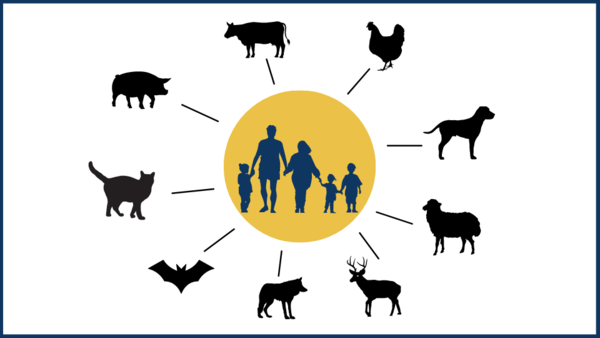Zoonoses

World Health Organization (WHO) defined zoonoses as diseases and infections which are naturally transmitted between vertebrate animals and man. Zoonoses are infectious in nature and are transmissible from animals to humans through direct contact or indirectly through contaminated food, water, vectors and environment. Of all the known pathogens that infect humans, more than 60% pathogens have extra human reservoirs and are zoonotic in nature. List of pathogens known to be infectious and capable of causing disease in humans under natural conditions is very exhaustive. There are approximately 1415 infectious agents known to be pathogenic to humans. Their distribution consists of 217 viruses and prions, 538 bacteria and rickettsia, 307 fungi, 66 protozoa, and 287 helminths.
Domestic and wild animals are the reservoirs and transmitters of numerous zoonotic pathogens. In last few decades, global emergence and spread of new pathogens and infectious diseases have been recorded. These are known as Emerging infectious diseases (EID) and over 70% EID are zoonotic diseases. Some of the recent examples of emerging diseases are SARS, MERS, Highly Pathogenic Influenza Viruses, etc. Nearly two third of the zoonoses are recorded from wild animals. These pathogens are maintained in the sylvatic cycle. Wild canines, small mammals like rodents, and bats are predominant reservoirs of zoonotic agents. Domestic animals like cattle, buffalo, goat, sheep, equines, camel and pigs, pets like dogs and cats, and poultry birds may transmit some of the zoonotic pathogens directly or indirectly.
The effect of zoonotic diseases can be evaluated in multiple ways like its impact on human livelihood and food security. Some zoonotic diseases greatly affect animal health and production. Dogs and cats have been human companions for more than a thousand years and their place in modern human civilization is at its apex. They are as good as family members to the pet owners, however owners must be aware about the zoonotic risks associated with their pets, and its management as they can be a source of viruses, bacteria, parasites, and fungi.
To know more about zoonoses, you can also visit sources like:
